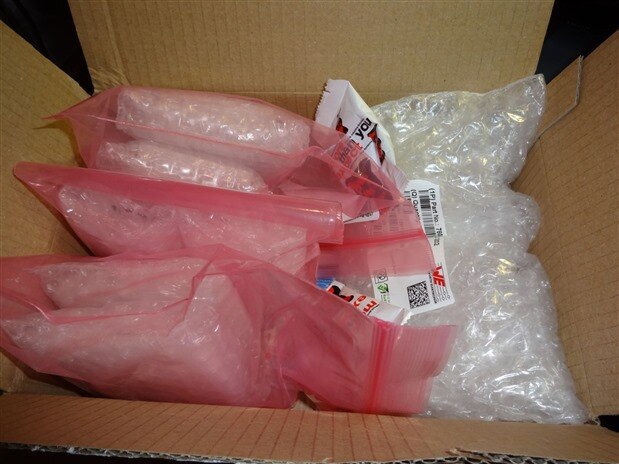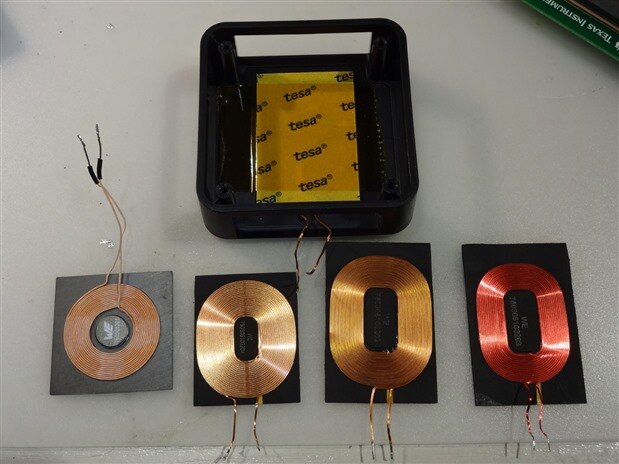(As usual - find the English version of this post on my personal blog)
Würth war so freundlich, mir schon vor ein paar Wochen zusätzliche Empfängerspulen zur Verfügung zu stellen. Eigentlich hatte ich, als das Angebot kam, nur um eine ganz bestimmte nachgefragt, aber jemand bei Würth meinte dass es eine gute Idee wäre mir gleich zwei Exemplare von jeder Variante zu schicken, die sie im Katalog haben.
Das bedeutet natürlich, dass ich mal wieder eine Messreihe durchführen muss, um herauszufinden welche Spule denn nun am besten für meine Zwecke geeignet ist.
Wenn man die 8 Spulen so gut verpackt wie Würth das getan hat, brauchen sie eine ganze Menge Platz:
Aber das ist auch nötig, das sie alle mit einer Ferrit-Basisplatte kommen, die ansonsten durchaus beim Transport zerbrechen kann. Über den Rest des Päckchens hat sich mein Sohn gefreut - er hat die Gummibärchen abgekriegt...
Messaufbau
Da es diesmal gleich 4 Spulen zu vermessen gab:
wollte ich nicht die vollständigen Messreihen des ersten Versuchen wiederholen. Daher habe ich lediglich zwei durchgeführt: jeweils eine ohne Last und eine mit 500 mA (letzteres entspricht in etwa dem was ich für später geplant habe). Wie gehabt habe ich die mögliche horizontale Verschiebung gemessen, bis die Ausgangsleistung abfällt. Zusätzlich habe ich aber diesmal auch untersucht, ob eine Verschiebung in eine andere Richtung eine Einfluß hat - die Spulen sind ja größtenteils rechteckig und nicht rund. Zusätzlich habe ich etwas genauer untersucht wie groß die vertikelen Abstände unter verschiedenen Bedingungen werden können. Der Versuchsaufbau ist dabei der geich wie vorher auch: passende Widerstände als Last, und passende Unterlagen als Abstandshalter.
Hier also meine Messergebnisse (die Reihenfolge der Spulen entspricht der auf dem Bild):
| Spule & Last | Abstand (vert.) | Versatz (hor., Laden) | Versatz (hor., Startup) | Stromaufnahme | Effizienz |
|---|---|---|---|---|---|
| 3737 - ohne Last | 1 mm | 11 mm | 8 mm | 105-130 mA | 0 % |
| 3737 - ohne Last | 3,5 mm | 12 mm | 11 mm | 140-230 mA | 0 % |
| 3737 - ohne Last | 10 mm | 13 mm | 10 mm | 340-550 mA | 0 % |
| 3737 - 500 mA | 1 mm | 12 mm | 9 mm | 600-625 mA | 83-80 % |
| 3737 - 500 mA | 3,5 mm | 13 mm | 10 mm | 625-690 mA | 80-72 % |
| 3737 - 500 mA | 10 mm | 13 mm | 10 mm | 700-1080 mA | 71-46 % |
| 3830 - ohne Last | 1 mm | 12 mm | 11 mm | 97-145 mA | 0 % |
| 3830 -ohne Last | 3,5 mm | 12 mm | 12 mm | 105-250 mA | 0 % |
| 3830 -ohne Last | 10 mm | 13 mm | 12 mm | 175-620 mA | 0 % |
| 3830 - 500 mA | 1 mm | 11 mm | 10 mm | 680-730 mA | 73-68 % |
| 3830 - 500 mA | 3,5 mm | 12 mm | 12 mm | 660-800 mA | 76-62 % |
| 3830 - 500 mA | 10 mm | 13 mm | 12 mm | 715-1250 mA | 70-40 % |
| 4832 - ohne Last | 1 mm | 12 mm | 10 mm | 105-205 mA | 0 % |
| 4832 - ohne Last | 3,5 mm | 13 mm | 11 mm | 130-330 mA | 0 % |
| 4832 - ohne Last | 10 mm | 14 mm | 11 mm | 250-750 mA | 0 % |
| 4832 - 500 mA | 1 mm | 12 mm | 9 mm | 640-680 mA | 78-73 % |
| 4832 - 500 mA | 3,5 mm | 13 mm | 12 mm | 640-810 mA | 78-62 % |
| 4832 - 500 mA | 10 mm | 14 mm | 11 mm | 690-1205 mA | 72-42 % |
| 4832 (rot) - ohne Last | 1 mm | 10 mm | 8 mm | 105-140 mA | 0 % |
| 4832 (rot) - ohne Last | 3,5 mm | 12 mm | 10 mm | 120-240 mA | 0 % |
| 4832 (rot) - ohne Last | 10 mm | 13 mm | 10 mm | 250-640 mA | 0 % |
| 4832 (rot) - 500 mA | 1 mm | 10 mm | 8 mm | 640-670 mA | 78-75 % |
| 4832 (rot) - 500 mA | 3,5 mm | 12 mm | 10 mm | 640-730 mA | 78-68 % |
| 4832 (rot) - 500 mA | 10 mm | 12 mm | 10 mm | 700-1100 mA | 71-45 % |
In der zweiten Tabelle habe ich nochmal die elektrischen Daten zusammengefasst, und die maximalen Entfernungen (die ich auch für die originale Spule nachgemessen habe):
| 3737 | 3830 | 4832 | 4832 (rot) | original | |
|---|---|---|---|---|---|
| Induktivität (µH) | 10 | 16,7 | 12 | 12 | 10,5 |
| Widerstand (Ohm) | 0,16 | 0,29 | 0,16 | 0,33 | 0,2 |
| max. Strom (A) | 4,5 | 2 | 3 | 1,55 | |
| Versatz (hor., Laden) um 90° gedreht | 11 mm | 12 mm | 13 mm | 11 mm | 13 mm |
| max. Abstand (vert., 500 mA) | 11 mm | 15 mm | 15 mm | 15 mm | 15 mm |
| max. Abstand (vert., Startup, ohne Last) | 11 mm | 13 mm | 11 mm | 12 mm | 11 mm |
| max. Abstand (vert., Startup, 500 mA) | 10 mm | 11 mm | 11 mm | 11 mm | 10 mm |
Ergebnisse
Aus der ersten Tabelle kann man ersehen, dass die mögliche Effizienz zwischen den Spulen recht stark variiert, und sich das auch anhand der Bedingungen verändert. So ist z.B. die kleinste Spule (37x37mm) für kleine Entfernungen am besten geeignet, während die 38x30mm große für größere Entfernungen die besten Ergebnisse liefert. Die 48x32mm-Spule kann mit den größten horizontalen Verschiebungen arbeiten (wobei die rote Version trotz höherer Effizienz dort deutlich schlechter abschneidet).
Was man auch sehen kann ist dass die Richtung, in der die Spulen gegeneinander verschoben sind keine Rolle spielt. Unabhängig von der Orientierung der Spulen ist die maximale Entfernung, bis zu der man eine Übertragung aufrecht erhält, gleich. Ich denke das liegt daran dass hier der Mittelpunkt der beiden Spulen wichtig ist, und dass die Sender-Spule ja rund ist.
Bei den Messungen sind mir noch zwei weitere Effekte aufgefallen. Als Erstes fiel auf dass bei einigen der Spulen die Ausgangsspannung kurzzeitig recht stark abfällt, wenn man sie verschiebt. Besonders ist das bei der 38x30mm-Spule aufgefallen. Zweitens habe ich irgendwann gemerkt, dass das leise Fiepen fehlte, welches bei der originalen Spule aufgefallen war.
Für mein Projekt, bei dem ja die genaue Ausrichtung der Spulen eher schwierig wird, sieht die 38x30mm-Spule am besten aus. Sie liefert nicht nur eine höhere Effizienz als die originale Spule (und das obwohl sie die schlechteste der 4 hier ist), sondern arbeitet auch über größere Entfernungen als die anderen. Selbst wenn man den Empfänger direkt in eine Last von 500mA starten lässt geht das über Entfernungen von mehr als 10mm. Damit lässt sie mir die größte Flexibilität bei der mechanischen Gestaltung und in der späteren Benutzung.
Ausblick
Während ich in der Vorbereitung der Messungen hier war, kam von Würth das Angebot für die Teilnehmer hier, auch ihre neuen Sender-Spulen testen zu können (und das sogar noch bevor sie offiziell auf element14 verfügbar sind). Damit wird es natürlich noch eine weitere Messreihe geben müssen...
Vorher wird es aber erstmal darum gehen, wie man ein Akku-Pack zusätzloich schützen sollte. Daher wird sich der nächte Beitrag mit einem Unterspannungsschutz befassen.



Top Comments
-

ForcisConnect
-
Cancel
-
Vote Up
0
Vote Down
-
-
Sign in to reply
-
More
-
Cancel
Comment-

ForcisConnect
-
Cancel
-
Vote Up
0
Vote Down
-
-
Sign in to reply
-
More
-
Cancel
Children